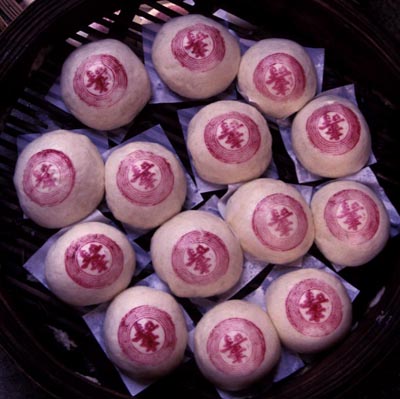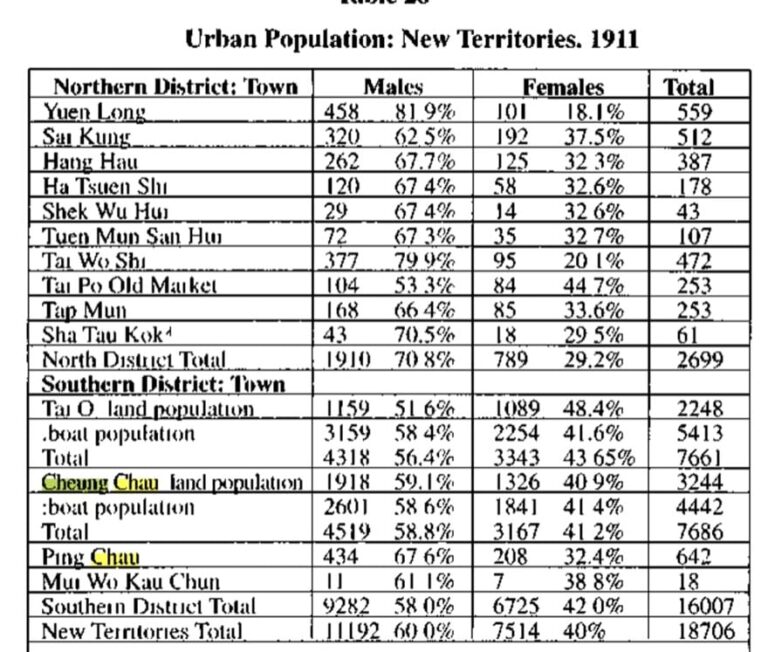| The Cheung Chau Bun Festival is a kind of Jiao Festival – a festival that a village might hold every year or every few years. More specifically, it’s a Tai Ping Qing Jiao [literal meaning: “the Purest Sacrifice celebrated for Great Peace”]. Such festivals were perhaps widespread across south China, but under Mao were regarded as feudal superstition, and were suppressed in mainland China. The origins of the Bun Festival are unclear. Choi Chi-cheung – a history professor in the Chinese University of Hong Kong – noted that while many people related it to misfortunes brought by pirates and disease during the Qing dynasty (1644-1912), two old men said it was originally held on Hong Kong Island, in Taipingshan – where many people were killed by bubonic plague. They said a man from Huizhou (Hailufeng) asked Pak Tei (Beidi) to stop the plague, other residents joined his prayers, and the disease subsided. Later, the festival was banned in Taipingshan, as fire regulations were tightened. The festival was transferred to Cheung Chau, where there was a strong Huizhou community in Pak She Street. Regarding Pak Tei becoming like the island’s patron saint: I have also read of ways he helped islanders in times of crisis, especially when plague struck in the late 19th century. Then, his first emissary was a stranger known as the Crane Brother, who rode about in a chair with knife blades for seat, arms and footrest. The plague subsided. It returned again after Crane Brother left, and a local took a turn in the chair, and the benevolent Pak Tei again came to the rescue. | 長 洲包山節是一種”打醮”活動,每個地方慶祝的時間都不同,有的一年一次,有的每隔幾年才慶祝一次,而長洲的包山節則屬於每年都會慶祝的節日。更具體地說, 應該叫它太平清醮 [它是一種祭祀 ─ 為祈求潔淨、國泰民安的儀式。] 。在華南地區很多地方都會慶祝這個節日,但是在毛澤東時代,它被視為封建迷信,隨即被壓制。 太平清醮的起源眾說紛紜,根據香港中文大學歷史系蔡志祥教授指出,很多人認為太平清醮與在清朝(1644-1912)時來的海盜和疾病有莫大關聯。 蔡教授曾訪問兩位居住長洲的老人,他們說太平清醮本來在香港島太平山舉行的,因當時有許多人死於瘟疫,然後有一名惠州(陸豐)的男子向北帝祈求,冀望瘟疫 會停止,其他居民也陸續加入了他的禱告,最後瘟疫真的停止了,為了答謝神恩,於每年都會有祭祀的儀式舉行。後來由於防火條例的收緊,祭祀活動在太平山被禁 止,隨後此活動轉移到在長洲舉行─因那裡有一個強大的惠州組織。 北帝開始成為島上的守護神,是在19世紀晚期─當受到瘟疫衝擊的時期。那時,一個陌生人自稱是北帝的使者,他坐在放了刀片的座位上,手臂和腳都置放在刀片 上,然後瘟疫神奇地平息了,但當他離去的時候,疫病又再次出現;於是人們再向北帝祈求,以滅疫病。 |
A helpful god, and ghosts of pirate victimsA similar tale is related by Joyce Savidge in This is Hong Kong: Temples. But in this version, an image of Pak Tei was paraded during a plague on Cheung Chaun in 1777, and a black wooden statue of Pak Tei was paraded on a sedan chair to help reduce another plague in the late 1800s. The statue was so effective that it was borrowed by people (also from a C Savidge noted that Cheung Chau elders said the festival began to thank Pak Tei for saving islanders. Around the same time, workmen digging foundations for new houses found mutilated bodies and human bones – perhaps the victims of pirates. Islanders became prone to blaming mishaps on ghosts of these victims, and began holding religious ceremonies to placate them. In time, the thanksgiving to Pak Tei and the ghosts’ placating ceremonies were merged to become the Bun Festival. Whatever the exact origins, the festival was originally only celebrated by the Huizhou ethnic group (in turn belonging to the Hoklo) on Cheung Chau; and by the time it began, the Huizhou folk were all or mainly land people – so it is not, as I’d long assumed, a festival that strongly belongs to Cheung Chau’s fisherfolk. Even today, the rituals, priests and opera reflect the Huizhou origins. | 一個幫助人們和和冤魂的神在Joce Savidge所著的 This is Hong Kong: Temples.書內也有提到類似的故事。但在這版本中,北帝是在1777年出現瘟疫的時候出現的,而在1880年代未,北帝是一個有形的神明─一個以黑 色木雕的神像出現(此神像是人們從香港的潮州會所借來的)。神像被安放在一轎子內在小島巡遊,望神明可壓制疫病。 Savidge在書中指出,長洲的長者說有關節日的始起是人們感謝北帝救了島民。而大約在差不多的時間,有工人在挖掘新房屋地基的時候發現了碎屍和人的屍 骨─也許是被海盜殺害的人。島民變得容易將所有不好的事都歸咎於這些受害者的鬼魂作怪,於是開始舉行宗教儀式以安撫他們的靈魂。在安撫的同時也酬謝神恩, 最後演變成現在的打醮。 姑勿論確切的緣起為何,有一點可以肯定的是這節日本來只有住在長洲的惠州族群才可以慶祝;時至今日,無論在儀式、聘用的道士和神功戲都是源自惠州。 |
Huizhou only priestsIndeed, Choi relates a story from islanders, which tells of the organiser of the 1962 festival being from the Chaozhou ethnic group. He invited Chaozhou priests to perform the rituals, and they supposedly angered the deities so much that typhoon Wanda struck later that year, killing many people. Since then, apparently, the rule for the priests has been: Huizhou only. Until 1965, the festival was celebrated at Tung Wan (by the east beach), but that year it was moved to its current location: the playground in front of Pak Tei Temple. According to the two old men, groups from districts other than Hailufeng have only contributed to the Bun Festival since 1945. The Chaozhou community has since become important in organising the Bun Festival, though groups from districts . But Cantonese (Punti) groups play a lesser role, and the Tanka (boat people) only play a minor part: Choi noted that, at least until 1981, one of the Tanka’s patron deities, Hongsheng, sneaked back to his temple before the end of the main parade, so did not participate in the festival to its end. Until 1978, the three main bamboo towers were donated by Hailufeng groups, which according to local gossip and a police report were said to have links to Hailufeng triad societies in Hong Kong. Although the Bun Festival is like carnival blended with exorcism, triad links maybe continued. When I arrived on Cheung Chau in 1987, a friend here said the parade was local triads parading around. And in 2006, the Shenzhen Zen blogger reported – with, I think, more than a little artistic licence – “Thanks to W’s friend who is a Cheung Chau native, I learned the large group of men heading the march were the island triad, called Tai Pan Shan. Hundreds [!!] of largely menacing and sullen tattooed guys and their more cheerful looking wives, mothers, children, girlfriends paraded and waved, dressed in identical white T-shirts with Chinese script and dragons on the front and Coca Cola logos on the back.” | 只用惠州道士事實上,蔡教授於一個在1962年參與太平清醮的潮州人聽到這樣的一個故事:那一年因為主辦單位一反慣例,棄用潮州道士而聘用了潮州道士,所以激怒了神 明,引致當年颱風溫蒂的襲擊,令多人死亡。那次之後,每年的太平清醮決定嚴格遵守從前的規定─只用惠州道士。 直到1965年以前,太平清醮的慶祝活動在長洲的東灣舉行,但在1965年開始遷至目前的位置:長洲北帝廟廣場。 據島上兩位老人的說法,海陸豐以外的群體只在1945年之後才對太平清醮有所貢獻,潮州群體是為籌辦太平清醮的重要角色。但廣東人(本地人)所屬的團體和 蜑家人(漁民/水上人)只能參與一小部分的儀式。蔡教授指出,至少直到1981年,其中蜑家人信奉的神明─洪勝,每次都會在主巡遊之前被送回它的廟宇內, 俗稱「走洪勝」,共不會參與全程的儀式。 直到1978年,三個主要用竹搭建的包山,都是由海陸豐族群捐贈的,而據當地的謠言和警方報告指出:這又聯繫到黑社會。雖然打醮成為了嘉年華會結合普渡的 活動,但黑社會仍然持續參與。當我在1987年到長洲的時候,這裡的朋友說參加巡遊的是當地黑社會人士。 而在2006年,有一個叫Shenzhen Zen 的博客在他的網誌說道:”多虧w的朋友,他是一個在長洲土生土長的居民,讓我知道到了那一批在巡遊中拿著大旗的男子是屬於島內黑社會─那被稱為太平山的一 群。百多個長相有點凶悍且有紋身的男人和他們的妻子、母親、孩子、女朋友等等在巡遊中穿著相同的T-恤,前面印有中文字和龍的圖案,而背部則印有可口可樂 標誌” |
The bun scramble and the bureaucratsOn the last main night of the festival – late on the day of the parade – there used to be a scramble for the buns on the three main towers. This was evidently a rough and ready affair; in 1977, Joyce Savidge wrote: ‘ At exactly midnight, a gong sounds and all the young men who have taken part in the festival rush forward and begin to climb the 60-foot towers. Some climb up inside the tower and burst through at the top – for it’s the crowning bun and the banner on the top that will bring the best good fortune throughout the year. Without any thought for safety, the young men swarm all over the towers like bees over a honeycomb, collecting buns as fast as they can and stuffing them into pockets, baskets and sacks. It’s usually all over within 10 minutes, leaving three sorry-looking frames of bamboo, tattered paper and rough string. ‘ Given the bun towers are made of bamboo, and around 60 feet high, this would seem a dangerous practice. And in 1978, one of the towers collapsed during the race, resulting in over 100 people being injured – and the government banning the bun scramble. Bun Festival organisers have asked the government to allow the bun scramble to restart. But officials remained cautious (bureaucrats: doncha just love em!) – and instead opted to start a new scramble, up a specially built bun tower with a metal framework. Just 12 people were allowed to compete in the first race, in 2005, which was won by 23-year-old local fireman and bodybuilder, Kwok Ka-keung. All had to use safety harnesses. The new race did not impress some islanders, including race old-timers. As reported in a newspaper article, A Hong Kong tradition is revived, but carefully:
| 搶包山和官僚在包山節的最近一晚─即巡遊那天的晚上,會有一個搶包山的活動─搶掛在三個大包山上的包子。Joyce Savidge描寫了1977年的情況: ”準午夜的銅鑼聲響起,所有參加了搶包山的年輕人,開始攀上60英尺的包山塔。有些人則從塔的內部爬上去最頂部─人們都覺得拿到越接近頂端的包子就越好,因為他們深信拿到之後好的福氣會貫穿全年。 那是沒有任安全措施的活動,青年男子就像一群蜜蜂衝向在蜂窩般,盡可能地以極速收集包子,把它們放進籮筐麻袋裡。這通常都在10分鐘內就會結束,然後只會看到三個面目全非的包山塔。” 由於包山塔只是用竹子搭建的,約有60英尺高,要攀登似乎是一個危險的作法。而在1978年,一個包山塔在搶包山的過程中倒塌,造成超過100人受傷,於是政府下令禁止再舉行搶包山的活動。 建醮委員會曾要求政府再允許搶包山的重辦,但官員們仍然很謹慎。新的搶包山活動有特定的規則─一個專門為搶包山搭建的金屬框架包山塔,所有成員都必須使用 安全帶,而且只有12人被允許參加,以確保安全性。在2005年第一次重辦的搶包山活動,由當地土生土長的23歲消防隊員郭家明勝出。 新的搶包山活動不是所有島民都接受,有些報紙報導了有關新聞: 許多離島居民大吐苦水,認為新的搶包山與舊的很不相同。一位73歲的居民道:「舊的搶包山非常令人興奮,很多人一起衝向包山塔,我們不會像現在新式的搶包山活動般用繩子拴住身體。」 |
Plastic wrappers and plastic buns | 塑膠封套和塑膠饅頭 |

| Officials also decided that it was a potential health threat to keep steamed buns out on towers for three days, then knock them down and distribute them to islanders – even though it seems most people don’t eat whole buns, but maybe use small amounts for supposed medicinal benefits: Joyce Savidge wrote in 1977: “In the event of a backache, a cold, or perhaps a headache, a bit of the dried bun is broken off and dissolved in water or tea and drunk by the patient.” The officials decreed the buns had to be individually wrapped in clear plastic. This year, the officials have gone even further: plastic buns will be used on the climbing tower. Again, this has not impressed all islanders. A blogger quoted the (unlinkable) South China Morning Post in Meaningless Sport: ‘ Kwok Kam-chuen, who has prepared the 8,000 buns used in the climb since it was revived in 2004, said it was not the loss of business that bothered him as much as the loss of tradition…. The 58-year-old baker, who has made the buns for more than three decades, said the tradition had been further watered down by Leisure and Cultural Services Department safety measures, which include a 14-metre-tall steel tower rather than the traditional bamboo structure. “With the steel tower and plastic buns, the climb will be turned into just another sport. On one hand, I appreciate the concern for hygiene and safety. But on the other hand, the heritage value will be gone and the meaning will be lost.” ‘ These changes have arrived as the Bun Festival has become an important Hong Kong tourist attraction, bringing visitors from Hong Kong and overseas, who throng Cheung Chau, especially around the time of the main parade. | 政府官員覺得包子掛在包山上三天再分發予市民,即使大部份市民都不準備吃掉這些包子,但仍對健康構成潛在威脅。有的島民相信,掛在包山上的包子有藥用價值;。Joyce Savidge於1977年寫道:”萬一腰酸背痛、著涼了,或者是頭痛,島民大都把乾掉了的包子溶解在水中或茶中,再喝掉。”為保衛生,官員下令包子都必須單獨地用膠袋包著。 今年,更將新鮮包子改為塑膠包子掛在包山上。同樣地,並非所有島民都接受這樣的安排。一個博客引用南華早報的報導: 郭錦全先生,自2004年起,每年都準備8000包子,以備掛在包山上;今年他覺得有點困惑,不是因為損失了生意,是因為傳統的流失。 今年58歲的麵包師父,他製作出包子超過三十年了,他說由康樂及文化事務署設計的新搶包山活動和安全措施─包括那個14米高的鐵塔,而不是傳統的竹架子時,傳統其實已進一步淡化。 他說:”爬鐵的包山,搶塑膠的包子,其實已變成了另一種運動..一方面,我很欣賞當局的關注─為了衛生和安全;但在另一方面,傳統的價值將會消失,就完全失去了原有的意義。” 會有這樣明顯的改變,只因太平清醮已不再是屬於小島的節日,而是成為了香港一個重要的旅遊景點,每年都吸引很多香港及海外的遊客,尤其是在大巡遊的那一天。 |
Further infoThis article draws heavily on “Reinforcing Ethnicity: The Jiao Festival in Cheung Chau” by Choi Chi-cheung, in David Faure and Helen F. Siu, ed., Down to Earth: The Territorial Bond in South China, Stanford: Stanford University Press, 1995, pp. 104-22. Bun Festival in Cheung Chau is a web page written in 2005 by Dr. Sui-wai Cheung, with info, photos and a video clip. This is Hong Kong:Temples by Joyce Savidge (Government Information Services, 1977) has a chapter on Pak Tei (Pak Tai) Temple, mainly covering the Bun Festival. | 更多資訊這篇文章很多資料引用了蔡志祥博士寫的:”Reinforcing Ethnicity: The Jiao Festival in Cheung Chau”,此文章收錄在:David Faure and Helen F. Siu ed., Down to Earth: The Territorial Bond in South China, Stanford: Stanford University Press, 1995, pp. 104-22. Bun Festival in Cheung Chau是張小慧博士在2005年寫有關長洲太平清醮的網頁,此網頁可以看到打醮時的照片和短片。 This is Hong Kong:Temples by Joyce Savidge (政府新聞處1977出版)有一章節是寫有關北帝廟,也包含說明太平清醮. |

Safety is a good thing
It’s very much thanks to the police for stepping in and stopping it being so dangerous and akin to a miniature triad olympics, and suggesting how it could be improved. Nowadays it’s safe, fun, and people get free training to do climbing properly!